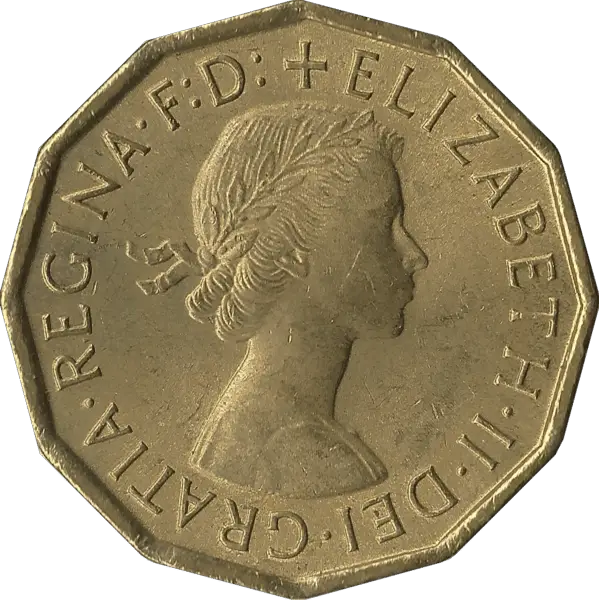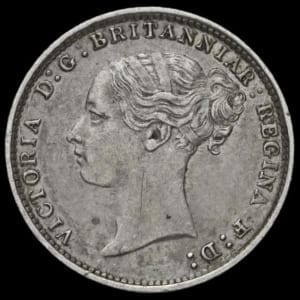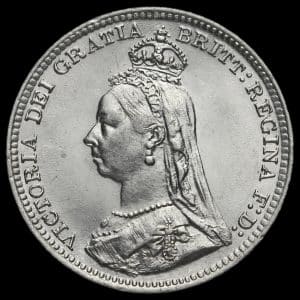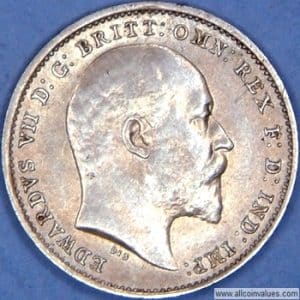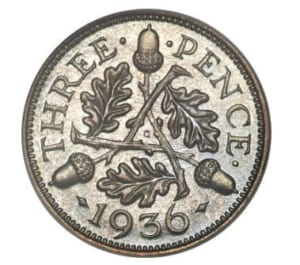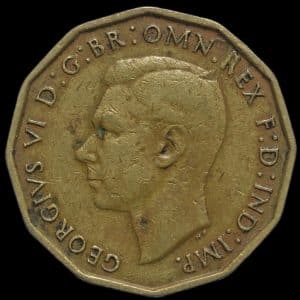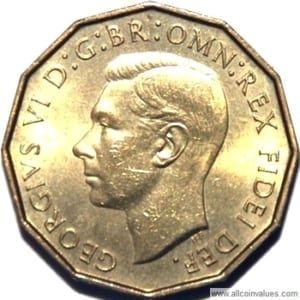Expired coins pre-dating the 1971 decimalisation system have become a popular niche for coin collectors throughout the UK and beyond, and one of these coins is the threepence – but how much is a threepence worth today?
The value of the threepenny fluctuates greatly from one era to the next due partly to varying interest levels from collectors and in part due to the maundy money versus general circulation. Meanwhile, a higher grading will naturally bump up the valuation compared to a G, VG, or F rating.
This may sound confusing at first, but in the rest of this article we’ll guide you through some key eras of threepence circulation and how much they’re worth.
Threepence History
The threepence, which is often expressed as 3d, is a coin that first entered circulation in the mid-16th century during the era of King Edward VI.
It was worth 1/80th of a pound, or ¼ of a shilling. The coin, albeit in several incarnations, remained in circulation right up until the decimalisation system came into effect.
In today’s money, this translates to one-quarter of 5 ‘new pence’, or 1.25 pence to be exact.
Interestingly, the coin also underwent a lot of changes throughout the centuries. While some eras saw them issued for general circulation, other periods used the threepence as maundy money. The coin has also been minted from nickel-brass as a 6.8g coin measuring 21mm and as a silver 1.5g coin with a diameter of 16.2mm.
While older incarnations of the coin used a plain edge, the threepence of Queen Elizabeth II’s reign was inscribed with “ELIZABETH II DEI GRA BRITT OMN REGINA F D” in 1953, and subsequently used “ELIZABETH II DEI GRATIA REGINA F D” until they ceased production in 1970.
The threepenny was additionally used in many countries of the Commonwealth, including Australia and New Zealand.
How Many Sides Did A Threepence Have?
The threepence was known for its 12-sided design, but this wasn’t always the case.
More specifically, the famous 12-sided design was only introduced in 1937, and before this, the threepence was actually round instead.
The 12-sided shape was famously reintroduced into circulation in 2017 when the Royal Mint updated the design of the one pound coin to a new 12-sided configuration which made counterfeiting more difficult.
Value Of Different Threepences Today
While it would take a lifetime to discuss the designs of every year from each monarch’s reign, here are some of the most significant threepence pieces from its four-century history, with a particular emphasis on the 19th and 20th centuries.
Victoria Young Head (1838-1887)
Estimated Value £1
Featuring the depiction of a young Queen Victoria, coins from most years in this era are worth around £10-£12. However, some years, such as 1852 (£60) and 1853 (£80) reflect increased rarity, caused by minting issues rather than becoming maundy money. Some years, like 1847 and 1848, are considered extremely rare and could fetch a four-figure sum if they feature high-quality grading.
Victoria Jubilee Head (1887-1893)
Estimated Value £2
Despite being in circulation for only a little over half a decade, the Victoria Jubilee Head coin is worth very little due to its large mintage.
It should be noted, though, that the final year of minting carries a greater value (£12) as the coin was replaced during this time, meaning fewer pieces were minted. EF graded coins from each year can fetch up to £20.
Victoria Old Head (1893-1901)
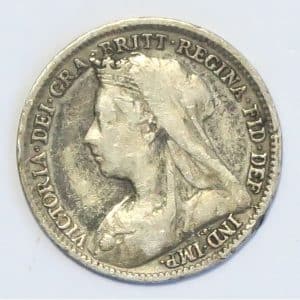
Estimated Value £2
Coins depicting the “old head” of Queen Victoria are also commonly available, meaning they fetch around £2 for F graded and £5 for VF graded coins.
There is very little movement between the different years of minting, but the coins remain popular among collectors despite their common nature and relatively low valuation.
Edward VII (1902-1910)
Estimated Value £2
Threepence pieces from the short reign of Edward VII are valued at just £2, although those minted in 1904 and 1906 are valued at £3. EF graded 3d coins from this time will fetch between £18 and £45, depending on the year. All of the 12-sided coins are inscribed with “EDWARDVS VII D G BRITT OMN REX F D IND IMP”.
George V Standard (1911-1936)
Estimated Value £minimal
Even with an EF grading, the general circulation George V coins are worth just a few pounds. Still, they remain a popular coin for collectors due to the fact there are four distinct designs throughout this era.
Type 1 (1911-1920) contains 0.925 silver, Type 2 (1920-1926) contains 0.5 silver, Type 3 (1926) carries a modified obverse image, and Type 4 (1927-1936) has a New Oak Sprig reverse.
George V Maundy (1927-1936)
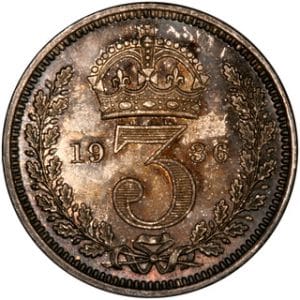
Estimated Value £40
To fetch £40, the silver George V maundy threepence needs to be in EF condition while Uncirculated graded coins can gain double this.
They are easily spotted due to the depiction of a number ‘3’ on the reverse, signifying the original value of the threepence. The maundy issues of these coins actually grow in value the later into the era you go.
George VI Type 1 (1946)
Estimated Value £6
While the Type 1 threepence of the George VI reign was minted from 1937 through to 1948, it’s the 1946 minted coins that are most noteworthy, partly due to no minting in 1947. They depict an IND IMP and are worth £240 at the EF grading. However, coins from the other years are worth as little as £1, even in this condition.
George VI Type 2 (1949)
Estimated Value £6
Most coins from the 1949 minting, which do not have IMD IMP printing, will be in F condition and are worth around £6. However, those at EF grading are worth £250. George VI Type 2 threepence coins in subsequent years up to 1952 are not worth very much but offer a cheap solution to boost a collection with the George VI depicted nickel-brass coin.
Queen Elizabeth II (1953-1967)
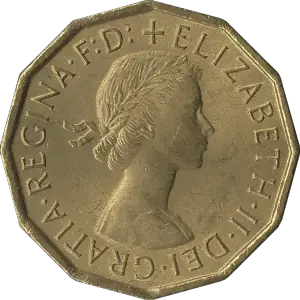
Estimated Value £4
While they didn’t go out of circulation until decimalisation took over, the Queen Elizabeth II nickel-brass coins stopped being minted in 1967. Due to their common nature, those with low gradings are worth pence. However, given their age, most can be found in EF condition, which can fetch a few pounds.
They depict the Queen’s head on one side and clearly state ‘THREE PENCE’ on the other.
Other Threepence Coins
The threepence pieces become increasingly difficult to find as you go back through the 18th, 17th, and 16th centuries. While it wasn’t in circulation for all reigns, the most noteworthy are Edward VI, Elizabeth I, and Charles I. Any 3d coin found from these eras is usually worth a few hundred pounds, and can potentially climb into the thousands.
What Is The Rarest Threepence Coin?
It’s incredibly hard to state with certainty which threepence is the rarest due to the many years that they were produced for Maundy sets, however, there is one particular year that stands out.
Between 1937 and 1945 the silver threepence was minted each year during King George VI’s reign, but it is the 1945 edition that is considered to be extremely rare.
This is because in this year it was ordered that all threepence coins were to be melted down for their silver content due to the decreasing popularity of the silver threepence. Despite this, there are so far two known examples that escaped from the melting process.
At an auction in April 1970 one of these 1945 George VI silver threepence coins sold for the equivalent of £4,000 in today’s money to an unknown buyer, with the other being graded and certified in 2019. The other recently sold for £62,000 in 2020, more than double its presale estimated value.
It is without a doubt that the 1945 George VI silver threepences are one of, if not the rarest threepence coins ever.
Frequently Asked Questions
Due to the vast history of the coin, there are many questions that we get asked around the topic of threepence coins and what they’re worth.
We’ve summed up the most common ones below, and if you have any other questions you would like to see answered don’t hesitate to let us know.
How Much Is A Threepence Worth In US Dollars?
Depending on the exchange rate at any given time, a threepence in today’s money would be the equivalent of just under 2 cents.
If you were looking to sell a threepence to a collector the value goes up substantially, and you can simply take the estimated values above and convert them to dollars.
What Were Threepence Coins Known As?
Threepence coins had a lot of nicknames during their time, and these included terms such as thruppenny bit and thruppence.
It’s very common for the older generation to refer to threepences with the nicknames above, so don’t be confused if you hear these terms.
When Did The Silver Threepence Cease To Be Legal Tender?
Silver threepences were no different to the nickel-brass variations and also ceased to be legal tender during decimalisation in 1971.
Final Thoughts
The threepence is a fascinating coin with a rich history that covered several incarnations during its 400-year lifespan, and this is reflected in the range of valuations depending on the age of your coin.
Still, they unquestionably make a great addition to any collection while those in the best grading can be sold for a very tidy profit.
